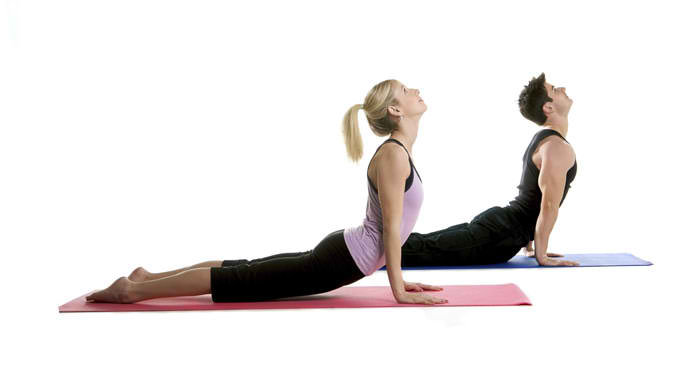 哈达瑜伽
哈达瑜伽
In our times, when we speak about yoga, we usually mean physical yoga exercises or asanas. But this is only a small part of tantra yoga-practical, scientific teaching, the aim of which is spiritual growth. The word yoga, as well as the word religion, means the union of the human soul with the Universal Soul, i.e., the union of human being with God. Although yoga is a product of Indian civilization and has influenced all religions of that land, it is a practical spiritual science that does not belong to any particular region or religion. It brings positive results independent of your belief in its efficacy.
Although the aim of yoga is spiritual perfection, it encourages a balanced, all-around development of human potential. We should use all the resources given to us for effective spiritual growth. Therefore, yoga contains in itself specific teachings that lead to bodily health and emotional well-being; it assuredly leads to intellectual, creative, intuitive and spiritual unfoldment. Just the opposite, for a yogi the body is a temple of the Spirit, a temple that should be scrupulously maintained.
Hatha yoga is mostly yoga that prepares the body for the spiritual path via physical and breathing exercises, and asceticism. Hatha yoga is the most superficial component of yoga, the one that is preoccupied merely with the means to the means. It prepares and conditions the body so that the mind can practice meditation more or less without obstacles. Hatha yoga, as a main rather than an accessory practice, is quite a tiresome and roundabout way to enlightenment.
The main component of hatha yoga, which has a special application to the spiritual path in asanas. The word asana means comfortable, stable pose. Asanas are exercises of a special kind. The form that they have taken is the result of a thousand years of experience: trial and error, experiments, and scrupulous observation. The yogis have discovered that certain positions of the body can give human beings qualities that they do not have or that are in deficit. Asanas are usually named in honor of their inventors (Matsyendra), certain bodily structures (a triangle), tools (a plow), birds (a peacock), or animals (a lion, e.g.) and reflect physical or psychological effects that these asanas have on a person. For instance, a snake pose makes the spine flexible; a frog pose helps the body to conserve energy and use much less food and water (like during hibernation); an action pose develops emotional and physical energy.
 Yoga postures should not be confused with mere exercise, calisthenics, which help strengthen and develop muscles. Asanas are special positions of the body that strengthen, purify and balance the endocrine, nervous and circulatory systems. While asanas are rarely prescribed to treat illnesses, they surely have healing properties and definitely prevent diseases. Many healers use asanas and other hatha yoga methods to effectively treat chronic illnesses and emotional disorders. If you practice asanas regularly, your body will gradually achieve greater endurance, your spine will become more flexible, your body will come to its natural weight and rid itself of toxins, you will breathe more easily, you will gain energy, your circulation will improve, your blood pressure will normalize, you will have an easier time coping with stress, and you will have more pleasant thoughts and fewer negative emotions. And considering all this, your overall mood will improve-in other words, you will gain vibrant physical and emotional health.
Yoga postures should not be confused with mere exercise, calisthenics, which help strengthen and develop muscles. Asanas are special positions of the body that strengthen, purify and balance the endocrine, nervous and circulatory systems. While asanas are rarely prescribed to treat illnesses, they surely have healing properties and definitely prevent diseases. Many healers use asanas and other hatha yoga methods to effectively treat chronic illnesses and emotional disorders. If you practice asanas regularly, your body will gradually achieve greater endurance, your spine will become more flexible, your body will come to its natural weight and rid itself of toxins, you will breathe more easily, you will gain energy, your circulation will improve, your blood pressure will normalize, you will have an easier time coping with stress, and you will have more pleasant thoughts and fewer negative emotions. And considering all this, your overall mood will improve-in other words, you will gain vibrant physical and emotional health.
The main application of asanas is the resolution of problems that appear on the path of meditation. Most of us, especially when we begin meditation practice, become surprised to what extent the mind are restless, unstable and full of various thoughts and desires. Emotions of anger, fear, hate and their derivatives torture us, while emotions of enchantment, infatuation and attachment (so-called love) and their derivatives delight us. Both kinds of emotions do not allow us to enter deep meditative states. Such mental disturbance happens due to the effect of mental modifications (vritti), which are trying to find external expression through the sensory organs and the nervous system (indriya), and therefore creating emotional confusion. Since vrittis are derivatives of endocrine glands, if you can regulate their (hormonal) secretions through asanas and other special yogic techniques, you will be able to regulate and control the emotions and the mind. Asanas squeeze and stretch glands, and thus invigorate and balance their secretions. As a result, endocrine defects are cured, and emotional and mental difficulties caused by these defects gradually disappear, without much effort and frustration on your part. Gradually the mind becomes calm and focused, i.e., ready for deep meditation.





